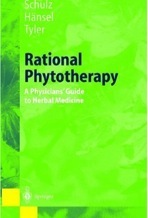Book Review






Rational Phytotherapy: A Physicians’ Guide to Herbal Medicine is an overview of the therapeutic use of botanicals, as well as its safety and efficacy. Phytotherapy is the study of the use of plants and herbs for medicinal means. Schulz et al go into fine detail about the science of botanicals in respect to its use as an herbal medicine. Many scientific aspects, such as the pharmacology and toxicology, efficacy in patients, and dosage risks, are reported with supportive data. Schulz et al cover such a wide range of herbal medicines organized by which bodily system or symptoms they treat most efficiently. Throughout the book, they provide images of the plants and herbs and graphs and tables of patient data; they also include a number of references after each chapter. This reference of herbal medicine was written by experts in medical education in Germany and they have made this reference available for English-speaking countries.
Rational Phytotherapy: A Physicians’ Guide to Herbal Medicine is organized in nine chapters and an appendix. The first chapter serves as an introductory to phytotherapy and pharmacology, as well as a brief section on medicinal teas. Most of the introduction is dedicated to providing a thorough explanation of the basics of phytomedicines: extraction methods, quality of herbs, quality control, liquid and solid dosage forms, and packaging. Phytotherapy is covered too; basic, preliminary information on therapeutic range, onset of action, patient expectations, and the benefits and risks that come with this type of therapy are covered. The section on medicinal teas offer the reader an in-depth tutorial on tea preparation and risks associated with it. Overall, the basis of the introduction chapter is to provide the reader with the basic knowledge of the science and the necessary detail behind herbal medicines.
Chapters two through nine cover the use of herbal medicines in more detail. Herbal medicines best used for the central nervous system, cardiovascular system, respiratory system, digestive system, urinary tract, gynecology, skin and connective tissues, and immune system are introduced and a biochemical rationale of its effectiveness. Some chapters are organized differently than the others; chapter 2, which covers the central nervous system, introduces the main plants and herbs used to treat symptoms revolving this system. Other chapters go ahead and list major symptoms relating to the subject of the chapter and then recommend the types of herbal medicines used to treat such symptoms, as well as information on its pharmacology, toxicity, efficacy, and risks. For example, for the chapter covering the digestive system, symptoms and conditions such as anorexia and dyspepsia, bloating and flatulence, gastritis and ulcer disease, irritable bowel system, acute diarrhea, constipation, and liver diseases are listed with types of herbal medicines that can be used for treatment. As usual, these herbal medicines are covered with great detail. The organization of these chapters could be done better; keeping the same format for each chapter would help the reader navigate through the book easily.
The appendix has a collection of tables and serves as a quick go-to reference for the top 100 commonly prescribed herbal medicines. The appendix is not organized alphabetically, so it may be difficult to find a certain medicine, but it is useful in that it lists its active constituents and how it is commonly prepared (extract, liquid, capsule, powder, juice).
Rational Phytotherapy: A Physicians’ Guide to Herbal Medicine is a reference, as the title suggests, for physicians and health care providers to learn the science behind herbal medicines. While some of the pharmacokinetic, dosage charts, and patient data may seem dry to the normal reader, sections of the text dealing with basic information on the herb or plant and its associated risks can be easily understood. The rest of the book, because it is deeply embedded in scientific research behind these medicines, is intended for people with at least a background in biology and chemistry. Overall, this reference on herbal medicines is a good and thorough one and will be best used for those most interested in the pharmacology and therapeutic aspect of herbal medicines.
“Members of the conventional medical community who are skeptical about the utility of phytomedicines often base their skepticism on the lack of human clinical trials for such products…now, they are provided with sound scientific information on the botany, chemistry, and pharmacology of the herb itself.”
–Varro Tyler
Tuesday, January 31, 2012



Rational Phytotherapy





